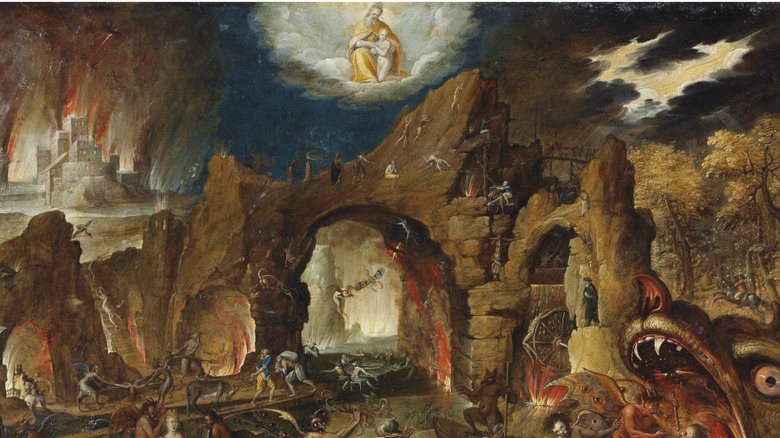Why Some Christians Think Jesus Went To Hell
A person could spend a lifetime untangling theological contradictions and affirming this or that biblical perspective — as people have done for 2,000 years. This is especially true when is comes to an unclear, confusing, and disputed line from the Apostle's Creed cited by Roman Catholics, Anglicans, and some Protestants.
The Apostle's Creed acts like a single-paragraph summary of core Christian doctrine. As The Gospel Coalition outlines, the disputed passage describes what happened to Jesus after he died: "He suffered under Pontius Pilate, was crucified, died, and was buried. He descended to the dead. On the third day he rose again. He ascended into heaven, and is seated at the right hand of the Father." The line "he descended to the dead" is sometimes translated as "he descended into Hell." This hellish event is most often alleged to have taken place in the three-day period of time after Jesus' death and before his resurrection. And with that statement, we're already neck deep in theological weeds.
The problem is: The Apostle's Creed isn't in the Bible. In fact, no one knows for sure where it came from. And the hell story? It's not in the Bible, either. It's an aggregate of allusions to various biblical passages. On top of this, we've got translation issues and loads of differing, intertwined concepts that get connected to our modern vision of "Hell:" Hades, Sheol, "the great chasm," "the abyss," "the lower regions," and more. Ultimately, the whole "Jesus went to Hell" story is nothing more than a fabricated, if memorable, tale.
[Featured image by Christie's via Wikimedia Commons | Cropped and scaled]
Art and the Apostle's Creed
The "Jesus went to Hell" story has been tremendously popular throughout Christian history despite not being exactly canonical. It's gotten its own moniker — "The Harrowing of Hell" — along with all sorts of imaginative, fiery, panoramic artwork, especially since the 15th century. One earlier depiction of the tale at St. Sophia in Kyiv, Ukraine dates back to the 11th century and is titled, "The Descent of Christ into Hell." Doubtlessly such artwork helped ignite people's imaginations and perpetuate the tale.
Such artwork has roots in the aforementioned Apostle's Creed. The Apostle's Creed evolved during the second and ninth centuries C.E., showing up in its earliest written form about 340 C.E., and in its first finalized form about 700 C.E. As Learn Religions says, the Apostle's Creed played an important role in concretizing Christian doctrine in its earliest days, especially in what fringe stuff it omits. And like other creeds — taking 325 C.E.'s Nicene Creed for example — the Apostle's Creed is an extra-biblical summary of conclusions, discussions, and narrative highlights.
The Gospel Coalition says that the Apostle's Creed gets its name from its traditionally taken source: Jesus' apostles. There's no evidence for this, however, and some researchers trace the creed back to an early recitation of Christian faith during baptisms called the "Old Roman Creed." No matter what, the creed developed over time lockstep with changes in Christian dogma. Somewhere along the way the hell part got included.
Extrapolating from the Bible
We've got to go further into theological territory to figure out exactly what the "The Harrowing of Hell" story even is, let alone figure out how the vignette worked its way into the Apostle's Creed and general Christian consciousness. For this, we've got to work within the framework outlined on biblical sites.
Sites like Compelling Truth quote 10 different Bible verses when describing the story about Jesus going to hell, none of which explicitly say that such a thing happened. Matthew 12:40, for instance, implies that it happened but doesn't say so directly, stating, "The Son of Man will be three days and three nights in the heart of the earth." Luke 23:43, meanwhile, implies the opposite when Jesus speaks to his fellow, crucified criminals, "Today you will be with me in paradise." "Today" means just that: no three-day sojourn in Hell. The closest we get to the tale comes from 1 Peter 3:19, which reads, "After being made alive, he went and made proclamation to the imprisoned spirits." And yet, no Bible verse actually describes such a hellish trip in any clear, narrative way. It's more of a portrait of a moment like The Harrowing of Hell artwork depicts.
The most critical, often-cited narrative point in the story about Jesus going to hell — that he went there between his death and resurrection (Good Friday and Easter Sunday) — is nowhere to be found anywhere. The post-death, pre-resurrection timeframe might have just made chronological sense and gotten taken as convention over time.
Translation and terminology problems
So we come to the final facet muddying the story of Jesus going to hell: translation and terminology issues. First up, we've got Sheol: the Old Testament Hebrew notion of the world of the dead that can also mean the literal ground in which dead people are placed. Then we've got Hades, as in: Yes, the three-part Greek underworld and eponymous name of its ruler, brother of Zeus. Hades comes up in the Bible because the New Testament was first written in Greek. Then we've got other terms like the "lake of fire" mentioned in Revelations, a different location from either Sheol or Hades that's kind of the final, eternal realm of torment for unbelievers. Then we've got yet other terms mentioned on sites like Got Questions, including, "the abyss," "the great chasm," "the grave," and more.
So where is "hell" in all this? Nowhere except in certain translations. Those translations, strictly speaking, are inaccurate and sometimes don't even distinguish between Sheol, Hades, and Hell. Even the Apostle's Creed itself, which kickstarted the semi-canonical nature of the Jesus in hell story, relates an incorrect translation if it uses the word "hell." The word "hell" made its way into Old English (about 450 to 1150 C.E.) via Scandinavian myth and the Old Norse goddess Hel, who presided over the land of the dead.
In the end, what's the story of Jesus going to hell in the Bible? Nothing, because it doesn't exist — either from a historical or theological angle.



